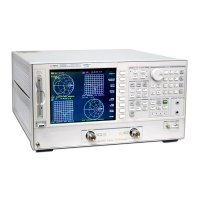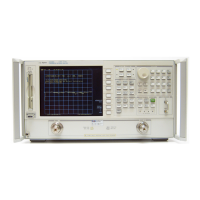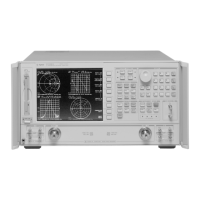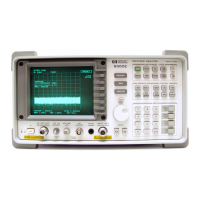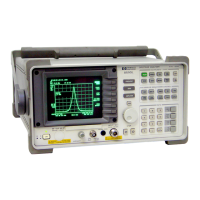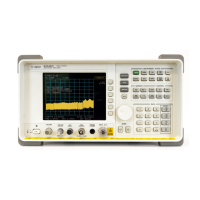Index
Index-3
memory math functions, 1-19
memory trace
viewing, 1-20
memory traces, 1-19
primary measurement
dual channel mode with decoupled
channel power
, 1-14
dual channel mode with decoupled
stimulus, 1-13
primary measurement channels, 1-12
viewing, 1-12
ratio measurements in channel 1 and
2, to
, 1-20
display intensity, 1-22
display markers
coupling, 1-31
uncoupling, 1-31
display markers, activating, 1-25
display memory, 1-19, 7-9
display reference value, setting, 1-38
display ripple test limits, 1-91
display ripple test values, 1-92
displayed measurement, titling, 4-30
displaying the bandwidth markers, 1-98
displaying the bandwidth value, 1-99
drift, frequency, 5-5
drift, temperature, 5-5
dual channel mode with decoupled
power
, 1-14
dual channel mode with decoupled
stimulus
, 1-13
dual-channel operation, 1-58, 7-88
duplexer, characterizing, 1-50
dynamic range, increasing, 5-14
E
ECal, 6-58–??
adapter removal calibration, 6-69–??
calibration, 6-58–6-68
confidence check, 6-65
equipment, 6-59
isolation calibration, 6-60
manual thru, 6-60
module information, 6-64
options, 6-60
service menu, 6-67
edit limits menu, 7-83
edit segment menu, 7-83
editing a sequence, 1-103
deleting commands, 1-103
editing line segments, 1-82
editing ripple limits, 1-88–1-90
electrical
length, 1-44
offset, 6-6
electrical delay, 7-35
electrical delay block, 7-8
electrical delay, determining, 6-73
electrical delay, setting, 1-39
electrically long devices, 5-4
electronic calibration. See ECal
eliminating unwanted mixing and
leakage signals, 2-6
embedding loop counter value in title,
1-109
enhanced frequency response error
correction
, 6-22
enhanced reflection error correction,
6-22, 6-25
enhancement, accuracy, 7-39
entering the power sensor calibration
data
, 6-34
deleting frequency signals, 6-35
editing frequency segments, 6-34
error
minimizing error while using adapters,
6-47
error correcting measurements, 6-10
error correction
enhanced frequency response, 6-22
enhanced reflection, 6-22, 6-25
frequency response, 6-12
full two-port, 6-29
one-port reflection, 6-26
error-correction, 1-5
stimulus state, 6-9
error-correction, vector, 7-8
errors, measurement, 7-40
exit HPGL mode, 4-24
sending to the printer, 4-24
external
calibration, 5-12
disk drive, 4-51
R channel inputs, 2-10
switches, controlling, 1-122
external source mode, 7-84
capture range, 7-86
compatible sweep types, 7-86
CW frequency range, 7-86
external source auto, 7-85
external source manual, 7-85
in-depth description, 7-85
locking onto a signal with frequency
modulation component
, 7-86
primary applications, 7-84
requirements, 7-86
typical test setup, 7-84
F
fabricating and defining calibration
standards for TRL/LRM
, 7-74
fast 2-port calibration, 5-12
fault location measurements using low
pass
, 3-18
features that operate differently in
sequence
, 1-108
feedthrough, RF, 2-46
file
deleting, 4-49
index numbers, 4-43
recalling, 4-50
renaming, 4-50
sequential CSV naming of, 4-43
to delete all, 4-49
filter, characteristics, 1-72
finite impulse width (or rise time), 3-27
fixed IF mixer adjustments
tuned receiver mode, 2-26
fixed IF mixer measurements, 2-26
addressing and configuring two
sources
, 2-29
calling the next measurement
sequence
, 2-29
decrementing the loop counter, 2-31
frequency list sweep of 26 points, 2-28
incrementing the source frequencies,
2-31
initializing loop counter value to 26,
2-29
labeling the screen, 2-31
presetting the instrument, 2-27
prompting user to connect mixer test
setup
, 2-28
response calibration, 2-28
sequence 1 setup, 2-26
sequence 2 setup, 2-31
taking data, 2-31
tuned receiver mode, 2-28
fixed markers, 1-29
fixtures, 6-48
designing your own fixture, 6-49
flat limit lines, 1-77
floppy disk, what you can save, 4-35
form feed sequence, 4-24
sending to the printer, 4-24
format, 7-9
format arrays, 7-9
format markers, polar, 1-32
formats, analyzer display, 7-25
formatting a disk, 4-51
forward stepping in edit mode, 1-108
forward transform measurements, 3-22
demodulating the results of the
forward transform
, 3-23
forward transform range, 3-24
interpreting the forward transform
horizontal axis
, 3-23
interpreting the forward transform
vertical axis
, 3-22
forward transform mode, 3-4
forward transform range, 3-24
